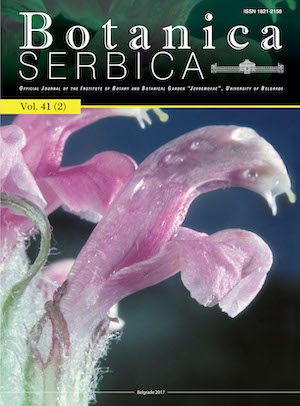
Volume 41 Issue 2 2017 |
Editorial
|
Professor Dr. Vladimir Stevanovic, full member of SASA (Serbian Academy of Sciences and Arts) – On the occasion of his 70th birthday
|
Recent progress in plant taxonomy and floristic studies in Greece
|
KEY WORDS: Flora Hellenica, Flora Hellenica Bibliography, Flora Hellenica Database, floristics, phytogeography, species diversity, Greece |
Overview of bryophyte flora research in Serbia with presentation of the Serbian BRYO database
|
KEY WORDS: mosses, liverworts, state of knowledge, history, the Balkans, bryology |
Fifty years of mapping the Balkan flora for Atlas Florae Europaeae
|
KEY WORDS: Atlas Florae Europaeae, plant distribution, uneven botanical knowledge, Balkan countries |
Geoecological characteristics of plant endemism in the Balkan part of Serbia
|
KEY WORDS: vascular plants, Serbia, endemism, physical geography, Balkan Peninsula |
Diversity of chasmophytes in the vascular flora of Greece: floristic analysis and phytogeographical patterns
|
KEY WORDS: cliff flora, chasmophytes, endemic taxa, range-restricted taxa, vascular plants |
Contribution to knowledge about nuclear DNA amounts in the family Asteraceae: first assessments in one genus and 12 species, with chromosome counts for three taxa
|
KEY WORDS: 2C-value, Asteraceae, Compositae, flow cytometry, nuclear DNA amount, vascular plants |
Phytosociological characteristics of seven poorly known associations of serpentine rocky grassland vegetation of the order Halacsyetalia sendtneri in Serbia
|
KEY WORDS: Balkan Peninsula, numerical analyses, phytosociology, syntaxonomy, serpentine, ultramafic grasslands |
Spread of Sporobolus neglectus and S. vaginiflorus (Poaceae) in Slovenia and neighbouring countries
|
KEY WORDS: invasive species, neophytes, Sporobolus neglectus, Sporobolus vaginiflorus, road banks, Slovenia, Europe |
Solanum pseudocapsicum L., an adventive species new for the flora of the Republic of Macedonia
|
KEY WORDS: Solanum pseudocapsicum, alien plant species, flora, Republic of Macedonia |
Book Review
|
|


